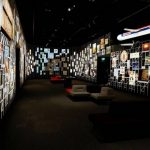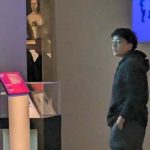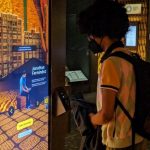By Professor Tiffany Banks On Tuesday, September 30th , students from my COMM 108: Foundations…
by Professor Ellen Olmstead
My goals for the trip were 1) to get students into the museums as few of them had visited any of the museums before and 2) to encourage them to explore ideas and resources for one of the essays required for ENGL 101-011.The class completed a survey to decide which museum/s we would visit. Perhaps because of this, there was no resistance to the trip, and all but one student arrived early!
Americans
On October 27th, my class visited the National Museum of the American Indian (NMAI) and the National Museum of American History (NMAH). 1 Our first stop was to the Americans exhibit at NMAI. Prior to this visit, I had the students complete the following:
- When you think of American Indians, what images or words come to mind? How does where you are from influence the way you think about American Indians? Who or what first taught you about American Indians, and what did you learn?
- Where do you see Indian imagery?
- Did you play any childhood games or with toys related to Indians? What about youth groups or camps?
- Have you played for or cheered a sports team with an Indian name or mascot?
- Do you buy products in the store with Indian names or mascots?
- Explore how a group of people is used to market a product.

National stories about our past can help build group identity, a sense of belonging, and pride. However, who decides how a national story is told? What is included or not included? Should national stories change over time? I wanted my students to think about the importance of national stories and consider how they shape our understanding of our shared history. Some questions to drive their thinking while we were there included:
- What is a national story of your family’s homeland? What does it tell us about that country?
- Do you celebrate Thanksgiving? Does celebrating Thanksgiving make you American? How? What do you eat? What does Thanksgiving say about the US? Resources for the First Thanksgiving:
- What are the symbols of America?
- What values make you American?
- How has your race, ethnicity, and/or gender influenced your personal values?
- How has your people’s story been told by others? How has it changed over time?
As with the Americans exhibit, for our visit to Entertainment Nation, there had been a pre-visit writing exercise.
- For more than 150 years, entertainment has provided a FORUM for important NATIONAL CONVERSATIONS about what kind of people we are—and want to be.
- Who tells your story?
- What are you watching?
- What’s your anthem?
While there, students were asked to consider how American entertainment differ from the predominant forms of entertainment in their ancestors’ home country.
Another choice was the exhibit, FOOD: Transforming the American Table

Our pre-visit writing questions included:
- What’s on your table?
- Is your family’s food tradition considered part of “American” cuisine?
- How has your diet changed over your life so far?
The students who visited Food were very engaged, particularly interested in how immigration and technology influenced our diet.
 Also on the list of exhibits they could visit was Many Voices, One Nation. Through almost 200 museum artifacts and about 100 loan objects, this exhibition shows how the many voices of the American people have contributed to and continue to shape the nation and its communities. Pre-visit and post-visit questions included:
Also on the list of exhibits they could visit was Many Voices, One Nation. Through almost 200 museum artifacts and about 100 loan objects, this exhibition shows how the many voices of the American people have contributed to and continue to shape the nation and its communities. Pre-visit and post-visit questions included:
- Where do you fit into this story of America? How well is your story represented, if at all?
- Do you live a transnational life?
- Do you see your family becoming more American with each generation? What does that involve/mean
- How does this exhibit compare with what you were taught in your US History class in high school?
- Compare and contrast the narratives in this exhibit with “Americans” at the Museum of the American Indian.
¡Presente!: A Latino History of the United States, is the last exhibit I will share here.
 ¡Presente! A Latino History of the United States offers a small sample of U.S. history from the perspectives of the diverse Latinas and Latinos who lived it and live it today. Over the next decade, while the National Museum of the American Latino is being constructed, this gallery will rotate its display of artifacts and stories to more comprehensively represent all the cultures/groups to be showcased in the new museum. Prompts the students had for this included:
¡Presente! A Latino History of the United States offers a small sample of U.S. history from the perspectives of the diverse Latinas and Latinos who lived it and live it today. Over the next decade, while the National Museum of the American Latino is being constructed, this gallery will rotate its display of artifacts and stories to more comprehensively represent all the cultures/groups to be showcased in the new museum. Prompts the students had for this included:
- How is Latino history American history? (How is Black history American history? Asian American history American history?..)
- What does it mean to be Latina/e/o/x? (What does it mean to you to be Black? Asian?…)
While this approach is particularly robust in its scaffolding, questions like these are an impactful way to allow students to be more present in the museum and gain more meaning from their experience.
Whether you are interested in visiting Americans at the National Museum of the American Indian and/ or Food: Transforming the American Table, Entertainment Nation, or ¡Presente!: A Latino History of the United States at the National Museum of American History, establishing a shared knowledge foundation prior to the visit and then guiding student thinking during and after will make for a rich learning experience for all!





This Post Has 0 Comments